Eyes
Eyes
The eye is a complicated organ composed of many small parts, each essential to normal vision. The ability to see clearly depends on how well these parts work together. The vision is the ability to use two eyes together to form one image. For accurate vision both eyes works smoothly, accurately, equally and simultaneously.

Facts on vision, categories and definition
Facts on vision impairment and blindness
- Today nearly 37 million people in the world are blind while another 124 million suffer from severe visual disabilities.
- Prevention or early treatment of the conditions that cause blindness could help avoid 80% of the blindness.
- Ninety percent of the world's blind live in developing countries.
- More than two-thirds of the world's blind are women.
- One-fourth of the world's blind people live in India; i.e., 9-12 million people.
- About 70% of the blind in India live in rural areas where good eye care is not available.
If effective action is not taken, the number of people with blindness and vision impairment will double by the year 2020.
Categories of vision
The World Health Organization (WHO) has specified several categories for the various degrees of vision, which is assessed through visual acuity measurements.
Visual acuity measures the ability of the eye to see detail. Visual acuity is usually measured by using a chart at 3 meters, 6 meters or 40 cm. The chart may have letters, numbers or shapes of different sizes. You can use the Snellen chart and look at the table below to see the different categories that visual acuity can be divided into. The table has both the WHO and Indian definitions'.
|
ategory |
Presenting Visual Acuity in the better eye |
WHO Definition |
Indian Definition |
|
0 |
6/6 - 6-18 |
Normal |
Normal |
Definition of low vision


Low vision is a condition where the vision cannot be improved to better than 6/ 18 with regular spectacles or any treatment. However, we can make the most of a person's remaining vision by using low vision devices like magnifiers and telescopes.
A person may have low but functional vision, i.e., he/she can use the vision for specific purposes. Even small amounts of vision can be useful, for example recognizing a person from up close, or avoiding bumping into objects. How useful the vision is depends on personal experiences and whether the person has been trained to make the most of his/her vision. It also depends on external factors like lighting and color of objects.
Causes of blindness and Visual impairment
Common Causes
Conditions that cause blindness and visual impairment
- Cataract
- Refractive Error
- Congenital eye anomaly
- Optic atrophy
- Corneal disease
- Glaucoma
- Retinal disease
- Amblyopic
- Others (Consanguineous marriages, trauma, etc.,)
It can be seen that cataract is the largest cause of blindness, and refractive error is the largest cause of visual impairment. Apart from this congenital eye anomaly, optic atrophy, corneal diseases, glaucoma, retinal disease, amblyopic are found to be cause for blindness or visual impairment.
Cataract and refractive error are the largest causes of blindness and visual impairment. These conditions cannot be prevented; however, sight can be restored by performing a simple operation for cataract, and by giving spectacles for refractive error. The treatment for these forms of blindness and visual impairment is one of the most successful and cost effective of all health treatments.
One of the reasons is that there may not be proper eye care services, or not enough trained care-givers. Sometimes people may not be able to access the eye care services sometimes due to costs involved in care, or because of cost of travel to long distances where the eye care centers are located. Sometimes they just accept their poor vision thinking that they can manage, this is especially true for older and elderly people.
Consanguineous marriages
Consanguinity or kinship is characterized by the sharing of common ancestors. The word is derived from the Latin consanguineous, meaning common blood.
Consanguineous individuals have at least one common ancestor in the preceding few generations. Consanguinity is defined as a situation in which two individuals who are related by blood, such as cousins, have a child together.
Genes, which come in pairs, are packages of information that we inherit from our parents. The risk of birth defects increases sharply when couples of a common ancestry have a child, as there is a higher chance of related individuals having a Common harmful gene that could be passed on to the child in two copies. The risk for birth defects associated with consanguinity increases according to the degree of relatedness, with more closely related couples having a higher risk. However, most consanguineous couples are able to have normal, healthy children.
Symptoms
A significant proportion of children born of consanguineous marriages do not live long or suffer from serious defects by six months of age. These are mostly diseases affecting the sense organs and the nervous system. Often the child's skin color is pink, the hair is white and the eyes lack an essential pigment. This condition is known as albinism.
Eye conditions related to consanguineous marriages are squint, night blindness, retinitis pigmentosa, photophobia, decreased visual acuity, nystagmus and refractive errors. Hereditary degeneration and atrophy of the retina, usually progressive, result in reduction of vision, leading to tunnel vision, and night blindness. This usually affects children and young adults.
Albinism: This is an inherited condition involving loss of pigmentation in the hair, skin and eyes. In ocular albinism, only the eyes are affected. This is usually associated with photophobia, decreased visual acuity, nystagmus and refractive errors.
Aniridia: This is a condition where the iris is congenitally absent.
Coloboma of Iris/Choroid: This is an absence of either of these structures because of a developmental abnormality.
Prevention
It is advisable to not marry blood relatives. Consanguineous couples who are expecting a baby or planning a pregnancy should go for genetic counseling to define the risks for the fetus and assess testing options.
Cataract
The lens of the eye helps focus objects at different distances from the eye. With the passage of time, the lens loses its transparency and turns opaque. A clouding of the lens is called cataract. Light cannot reach the retina and the vision diminishes gradually, even to the point of blindness. For most people the result is blurred and distorted vision.
Though cataracts usually occur in people above the age of 55, younger people are not immune to them. Cataracts are the main cause of blindness worldwide; four out of 10 people above the age of 60 develop cataracts. The only treatment is surgery, which is a safe and simple procedure.
The exact cause of cataract is not known. There are different kinds of cataracts; the most common one being senile cataract that develops in people above 50. Factors that may contribute to this change include disease, genetics, old age, or eye injury. People who are exposed to cigarette smoke, ultraviolet radiation (including sunlight), or certain medications are also at risk of developing cataract. Free radicals and oxidizing agents have also been connected to age-related cataract formation.
Symptoms
- Gradual deterioration in vision over time
- Objects appear hazy, distorted, yellow or blurred.
- Reduced vision at night or in low light at night colors may look dimmer and there may be poor night vision.
- Vision in sunshine or bright light is hampered by glare.
- Halos appear around bright lights.
- Cataracts do not cause itching, tearing or headaches.
Treatment
There is presently no drug that can restore the lens' transparency. Spectacles don't help since the rays of light cannot pass through the eye. The only way to treat a cataract is by surgical removal. There are several different types of cataract surgery.
A cataract may not need to be treated if the vision is only slightly blurry. Simply changing the spectacles' prescription may help improve the vision, but only for a while. Surgery should be scheduled when a patient is no longer able to see well enough to do the things he/she likes to do.
Glaucoma
Glaucoma is a disease that gradually destroys sight, due to severe and progressive damage to the optic nerve. When we look at an object, the image is carried from the retina to the brain by the optic nerve. In glaucoma the intraocular pressure exceeds the ability of the affected eye to tolerate it. This results in damage to the optic nerve, leading to loss of vision.
When looking at an object, a person with glaucoma sees only the center of the object. With the passage of time, even this is lost. In general, people rarely notice this until considerable damage has occurred. As glaucoma often develops without any symptoms, it is referred to as the "sneak thief of sight".
Glaucoma affects approximately six crore people globally and is the second most common cause of blindness in India. About one crore Indians suffer from glaucoma, of which 1.5 lakh are blind.
Glaucoma usually affects both the eyes. Though it usually occurs among adults above the age of 40, it can also affect newborn babies.
Types
There are two main types of glaucoma: primary open angle and angle closure glaucoma.
Primary open angle glaucoma
In primary open angle glaucoma the drainage canals of the eye become gradually blocked. The eye's inner pressure increases because the drainage system does not function properly. (However, the entrances to the drainage canals are usually working and not blocked.) The blockage occurs inside and the fluid cannot come out, thus increasing the pressure inside the eye.
There are no specific symptoms associated with primary open angle glaucoma. Periodical eye examinations are essential to identify glaucoma as early as possible. Then it can be controlled with medication.
Angle Closure Glaucoma
Angle closure glaucoma is an acute type of glaucoma. In this condition the pressure in the eye increases rapidly. The width of the iris and cornea is reduced, resulting in reduction of the drainage canal.
Symptoms
Adults
- Patients complain of loss of peripheral vision
- Patients may see halos or rainbow-colored rings or lights
- The vision may be blurred or foggy
- Patients may complain of pain and redness in the eye
- The field of vision is reduced so much that the patient cannot move about independently
- Secondary glaucoma should be suspected when there is an injury to the eye, followed by pain or loss of vision
- Patients with diabetes may also suffer from glaucoma
Children
The symptoms in infants and children include redness, watering, enlargement of the eyes, corneal clouding and photophobia.
Trauma
Eye trauma is a major cause of blindness in the eye. In most trauma cases people go blind due to lack of sufficient medical facilities or trained personnel. Eye injuries must be considered as emergencies and treated promptly. Immediate first aid and referral is essential for restoration of sight.
Causes
Household Injuries
- Cultivating and harvesting crops
- Cutting and splitting firewood
- Burning particles flying from firewood • exposure to flame or steam while cooking
- Insect stings or bites
- Dust particles (foreign body)
Industrial
- Metal particles (foreign body)
- Burning particles
- Flame or steam
- Facial lacerations
- Chemical burns
Accidents
- Broken glass from vehicles
- Injuries due to fall
- Penetration by sharp or blunt objects
Chemical Burns
- Immediate first aid is essential for chemical burns.
- Thoroughly wash the face, eyelids and the eye for at least five minutes as soon as possible.
- Pour more water into the eye's inner corner. Make sure that the chemical does not run into the other eye. Cover the eye with a dry, clean protective dressing shield.
- Caution the patient against rubbing eye.
- Get medical help immediately.
- Apply a soft pad, shield the eye and take the patient to a hospital immediately.
Harmful eye practices
- Self-medication
- Traditional eye medication - extracts from leaves or herbs/human urine/animal products that cause permanent damage to the ocular surface, visual impairment and blindness Foreign body in the eye
- Injuries due to a foreign body, such as wings of insects, dust, hot coal from firewood, metal
- Particles from machines and loose eyelashes. These common objects when lodged under the
- Eyelids can cause pain and redness, and must be removed at once.
Some important points to be noted while dealing with eye trauma
- Eye emergencies include cuts, scratches, and objects in the eye, burns, chemical exposure, and injuries with blunt objects. Since the eye is easily damaged, any of these conditions can lead to vision loss if left untreated.
- It is important to get medical attention for all significant eye injuries and problems. Many eye problems that are not due to injury (such as a painful red eye) still need urgent medical attention.
- A chemical injury to the eye can occur due to a work-related accident or by common household products, such as cleaning solutions, garden chemicals, solvents, etc. Fumes and aerosols can also cause chemical burns.
- In the case of acidic burns, the hazing of the cornea often clears and there is a good chance of recovery. However, alkaline substances - such as lime, commercial drain cleaners, and sodium hydroxide found in refrigeration equipment – can cause permanent damage to the cornea.
- At times, ongoing damage may continue to occur despite prompt treatment.
- Dust, sand, and other debris can enter the eye any time. Continuous pain and redness indicate that professional attention and treatment is required. A foreign body may threaten your vision if the object is likely to damage the cornea or lens. Foreign bodies propelled at high speed by achining, grinding, or hammering metal on metal present the highest risk.
- A black eye is usually caused by direct trauma to the eye or face. Certain types of skull fractures can result in bruising around the eyes, even in the absence of direct trauma to the eye. Often, swelling of the eyelid and tissue around the eye may also occur.
- Occasionally, serious damage to the eye occurs from the pressure of swollen tissue. Bleeding inside the eye can reduce vision, lead to glaucoma, or damage the cornea.
- Knowing what to do for an eye emergency can save valuable time and, possibly, prevent vision loss. Here are some instructions in case of basic eye injuries
Prevention for other ocular injuries
- Caution people about the dangers of self- medication and traditional practices.
- Do not take treatment from unqualified medical practitioners; see a qualified medical practitioner immediately.
- Keep medicines, drugs, acids, chemicals, hot foodstuffs and sharp objects away from children.
- Discourage children from playing with sharp objects, bows and arrows and gilli- danda.
- Use protective glasses while driving vehicles or while doing any industrial work.
- Learn about first aid procedures and be aware of the nearest medical facilities
Treatment
- Avoiding rubbing the eyes. In the case of children, tie the hands at the back if they don't obey.
- Remove the foreign object with a moist narrow swab or twisted corner of a handkerchief in bright light.
- If the foreign body is not visible, take some clean water in the hand and blink briskly in it.
- If still unsuccessful, pull the upper lid forward, push the lower lid upwards and let go of both the lids. The lashes of the lower lid can often dislodge the foreign body.
- If the foreign body is embedded in the cornea, apply a soft pad, shield the eye and take the patient to a hospital immediately.
Basic First Aid
Chemical Burns
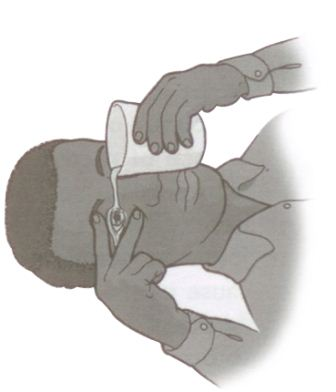
- Immediately flush the eye with water or any other drinkable liquid. Hold the eye under a faucet or shower, or pour water into the eye using a clean container. Keep the eye open and as wide as
- Possible while flushing. Continue flushing for at least 1 5 minutes.
- Do NOT use an eyecup.
- If a contact lens is still in the eye, begin flushing over the lens immediately. This may dislodge
- The foreign body on the lens. Flushing over the lens immediately may dislodge the foreign body on the lens.
- Do NOT bandage the eye.
- Seek medical treatment immediately after flushing.
Specks in the Eye
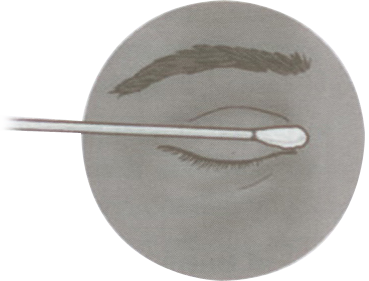
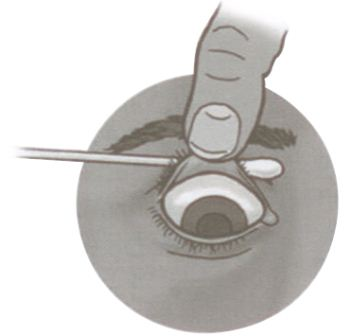
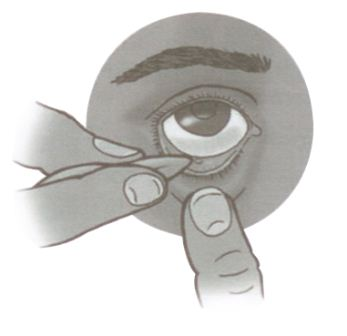
- Do NOT rub the eye.
- Try to let tears wash the foreign matter out of the eye or use an eyewash.
- Lift the upper eyelid outward and down over the lower lid to try and remove the foreign body.
- If the foreign matter does not wash out keep the eye closed, bandage it lightly, and see a doctor immediately.
- Blows to the Eye
- Apply a cold compress without putting pressure on the eye. Crushed ice in a plastic bag can be taped to the forehead to rest gently on the injured eye.
- In case of pain, reduced vision, or discoloration (black eye), seek emergency medical care. Any of these symptoms could mean internal eye damage.
Cuts and Punctures of the Eye or Eyelid
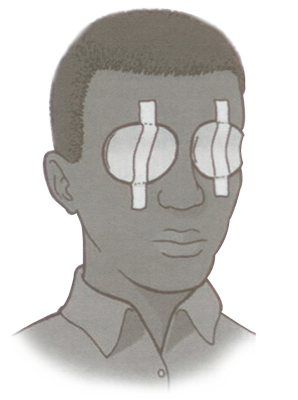
- Do NOT wash out the eye with water or any other liquid.
- Do NOT try to remove an object that is stuck in the eye.
- Cover the eye with a rigid shield without applying pressure. You can use the bottom half of a paper cup.
- See a doctor at once.
General precautions
- Do not rub the eyes when any small particles like charcoal, wood, sand, etc., fall in the eye.
- Open the eyes wide and wash with lots of clean, cold water.
- In case of corneal trauma due to injury with sharp objects - such as a blade of grass, the corner or edge of a paper, a pencil, a knife - or other injuries due to burns, hot water, oil, vapour, hot ashes, firecrackers, caustic soda, lime, acid or any other chemicals, wash the affected eye with clean water.
- Medical advice should be taken immediately from a qualified eye doctor.
- In case of a blunt injury, advise the patient to rest in a vertical position. Bandage both eyes with a sterile pad.
- Consult an eye doctor as soon as possible.
Preventive Steps
- Protect the eyes while performing all hazardous and sporting activities at home, while travelling and on the job.
- Stock a first-aid kit at your house and work place. Carry a travel kit with a rigid eye shield and commercial eyewash in case of an eye injury.
- Do NOT assume that any eye injury is harmless. If in doubt, see a doctor immediately.
Good eye health practices and First Aid
- Keep the eyes and the skin around the eyes clean by washing with soap and clean water.
- It is essential to wash the eyes before going to bed as it removes the dust and dirt collected throughout the day.
- Never use another person's towel, handkerchief or used clothes to wipe your eyes, as this may cause infection.
- Avoid using kajal or surma or any other material in the eyes. If you do, each person must use a separate applicator.
- Do not expose the eyes to dust, smoke or very bright light.
- Do not look at the solar eclipse with naked eyes.
- Flies carry diseases from infected persons to healthy persons. Keep your surroundings clean.
- Diabetes and hypertension can damage vision and lead to blindness. Keep them in control; get your eyes checked periodically.
- All toxic drugs, drinks and tobacco are harmful for health, even more for the eyes. Avoid such things.
- Keep away from children dangerous play things like bows and arrows, gilli- danda, and toys with sharp, pointed edges. Discourage children from playing with firecrackers without adult supervision.
- Use protective spectacles while doing jobs like welding and carpentry.
- Avoid self-medication. Do not use remedies sold by quacks or roadside medicine sellers. If you have any eye problems consult an eye specialist.
- If you use glasses, keep them clean and free from scratches. Never use other people's dark glasses, as this may lead to eye infection.
- Discourage children from playing hide and seek to prevent transmission of diseases by touching one another's eyes.
- Avoid using baking soda while cooking, because it destroys vitamins.
Good Reading Habit
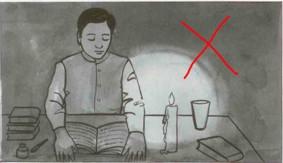
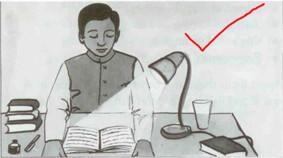
- Hold the printed page about a foot and a half away from the eyes and tilted at an angle of 45 to 70 degrees.
- Do not read in moving trains and buses, while lying down or in flickering/dim light.
- Do not read fine print under insufficient light
- Rest your eyes frequently when reading or doing concentrated eye work by either closing the eyes or looking at a distant object for a minute.
Source: Handbook for Community Eye Health Workers
Last Modified : 3/13/2020
Provides information about an intelligent AI-power...
